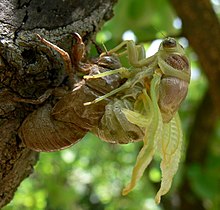Common singing cicada
| Common singing cicada | ||||||||||||
|---|---|---|---|---|---|---|---|---|---|---|---|---|

Lyristes Plebejus in Greece |
||||||||||||
| Systematics | ||||||||||||
|
||||||||||||
| Scientific name | ||||||||||||
| Lyristes plebejus | ||||||||||||
| ( Scopoli , 1763) |
The Common leafhopper ( Lyristes plebejus ) belongs to the family of leafhoppers (Cicadidae) within the order of Risso cicadas (Cicadomorpha).
distribution
The common singing cicada occurs in the Mediterranean region of Europe and Asia Minor . It populates tree tops of cypresses , pines , eucalyptus trees and palms .
Physique and characteristics
The adult animals reach a size of 40 to 60 millimeters, have a dark thorax and abdomen. In contrast to the Cicada orni, common singing cicadas are up to 15 millimeters wide. The complex eyes ( compound eyes ) are green in young animals, blue or dark brown in adult animals. The wings are folded together like a roof. The X-shaped, white markings under the thorax are characteristic.
Life cycle, reproduction and development
The underground cicada larvae suck the sap from the plant roots. In order to be able to move around better underground, their front legs have been converted into grave legs. The hemimetabolic insects go through five larval stages separated by moults, during which they gradually become more and more similar to the adult animal. They become gradually larger and larger and with increasing age, the systems for the wings and genital fittings increase. When the weather is good, usually at the beginning of August, they leave the ground, leaving a loophole and look for suitable places in the vegetation in the area . There they molt one last time to become a full insect. The newly hatched adult animals ( Imagines ) are initially soft and green. You need about four to five days until they are completely colored and the chitin shell is completely hardened.
Common singing cicadas fly in danger; in doing so, they excrete a secretion from the abdomen, which may consist of sucked plant sap and is intended to frighten the enemy.

nutrition
Like all singing cicadas , the common singing cicada is a xylem sucker . With the help of their proboscis, the adult animals prick the pathways of various trees and shrubs and suck the sap, which is rich in nutrients and water. The subterranean larvae suck the sugar-rich sap from roots.
photos
Another Lyristes art is gemellus Lyristes, she comes around the Aegean Sea before
Individual evidence
- ↑ The sizes of the animals apply to both females and males.







